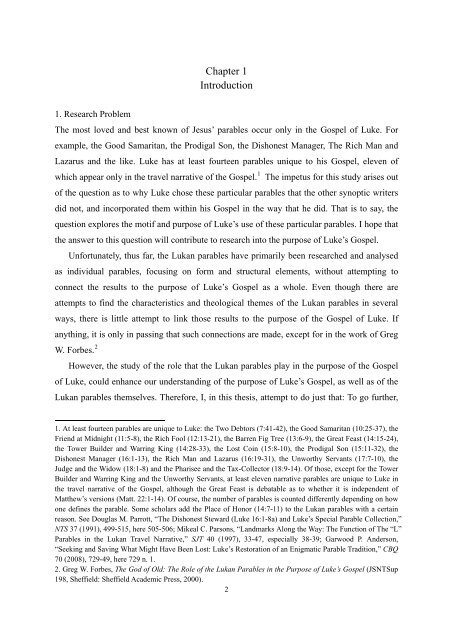the role of the lukan parables in terms of the purpose of luke's gospel
the role of the lukan parables in terms of the purpose of luke's gospel
the role of the lukan parables in terms of the purpose of luke's gospel
Create successful ePaper yourself
Turn your PDF publications into a flip-book with our unique Google optimized e-Paper software.
Chapter 1<br />
Introduction<br />
1. Research Problem<br />
The most loved and best known <strong>of</strong> Jesus’ <strong>parables</strong> occur only <strong>in</strong> <strong>the</strong> Gospel <strong>of</strong> Luke. For<br />
example, <strong>the</strong> Good Samaritan, <strong>the</strong> Prodigal Son, <strong>the</strong> Dishonest Manager, The Rich Man and<br />
Lazarus and <strong>the</strong> like. Luke has at least fourteen <strong>parables</strong> unique to his Gospel, eleven <strong>of</strong><br />
which appear only <strong>in</strong> <strong>the</strong> travel narrative <strong>of</strong> <strong>the</strong> Gospel. 1<br />
The impetus for this study arises out<br />
<strong>of</strong> <strong>the</strong> question as to why Luke chose <strong>the</strong>se particular <strong>parables</strong> that <strong>the</strong> o<strong>the</strong>r synoptic writers<br />
did not, and <strong>in</strong>corporated <strong>the</strong>m with<strong>in</strong> his Gospel <strong>in</strong> <strong>the</strong> way that he did. That is to say, <strong>the</strong><br />
question explores <strong>the</strong> motif and <strong>purpose</strong> <strong>of</strong> Luke’s use <strong>of</strong> <strong>the</strong>se particular <strong>parables</strong>. I hope that<br />
<strong>the</strong> answer to this question will contribute to research <strong>in</strong>to <strong>the</strong> <strong>purpose</strong> <strong>of</strong> Luke’s Gospel.<br />
Unfortunately, thus far, <strong>the</strong> Lukan <strong>parables</strong> have primarily been researched and analysed<br />
as <strong>in</strong>dividual <strong>parables</strong>, focus<strong>in</strong>g on form and structural elements, without attempt<strong>in</strong>g to<br />
connect <strong>the</strong> results to <strong>the</strong> <strong>purpose</strong> <strong>of</strong> Luke’s Gospel as a whole. Even though <strong>the</strong>re are<br />
attempts to f<strong>in</strong>d <strong>the</strong> characteristics and <strong>the</strong>ological <strong>the</strong>mes <strong>of</strong> <strong>the</strong> Lukan <strong>parables</strong> <strong>in</strong> several<br />
ways, <strong>the</strong>re is little attempt to l<strong>in</strong>k those results to <strong>the</strong> <strong>purpose</strong> <strong>of</strong> <strong>the</strong> Gospel <strong>of</strong> Luke. If<br />
anyth<strong>in</strong>g, it is only <strong>in</strong> pass<strong>in</strong>g that such connections are made, except for <strong>in</strong> <strong>the</strong> work <strong>of</strong> Greg<br />
2<br />
W. Forbes.<br />
However, <strong>the</strong> study <strong>of</strong> <strong>the</strong> <strong>role</strong> that <strong>the</strong> Lukan <strong>parables</strong> play <strong>in</strong> <strong>the</strong> <strong>purpose</strong> <strong>of</strong> <strong>the</strong> Gospel<br />
<strong>of</strong> Luke, could enhance our understand<strong>in</strong>g <strong>of</strong> <strong>the</strong> <strong>purpose</strong> <strong>of</strong> Luke’s Gospel, as well as <strong>of</strong> <strong>the</strong><br />
Lukan <strong>parables</strong> <strong>the</strong>mselves. Therefore, I, <strong>in</strong> this <strong>the</strong>sis, attempt to do just that: To go fur<strong>the</strong>r,<br />
1. At least fourteen <strong>parables</strong> are unique to Luke: <strong>the</strong> Two Debtors (7:41-42), <strong>the</strong> Good Samaritan (10:25-37), <strong>the</strong><br />
Friend at Midnight (11:5-8), <strong>the</strong> Rich Fool (12:13-21), <strong>the</strong> Barren Fig Tree (13:6-9), <strong>the</strong> Great Feast (14:15-24),<br />
<strong>the</strong> Tower Builder and Warr<strong>in</strong>g K<strong>in</strong>g (14:28-33), <strong>the</strong> Lost Co<strong>in</strong> (15:8-10), <strong>the</strong> Prodigal Son (15:11-32), <strong>the</strong><br />
Dishonest Manager (16:1-13), <strong>the</strong> Rich Man and Lazarus (16:19-31), <strong>the</strong> Unworthy Servants (17:7-10), <strong>the</strong><br />
Judge and <strong>the</strong> Widow (18:1-8) and <strong>the</strong> Pharisee and <strong>the</strong> Tax-Collector (18:9-14). Of those, except for <strong>the</strong> Tower<br />
Builder and Warr<strong>in</strong>g K<strong>in</strong>g and <strong>the</strong> Unworthy Servants, at least eleven narrative <strong>parables</strong> are unique to Luke <strong>in</strong><br />
<strong>the</strong> travel narrative <strong>of</strong> <strong>the</strong> Gospel, although <strong>the</strong> Great Feast is debatable as to whe<strong>the</strong>r it is <strong>in</strong>dependent <strong>of</strong><br />
Mat<strong>the</strong>w’s versions (Matt. 22:1-14). Of course, <strong>the</strong> number <strong>of</strong> <strong>parables</strong> is counted differently depend<strong>in</strong>g on how<br />
one def<strong>in</strong>es <strong>the</strong> parable. Some scholars add <strong>the</strong> Place <strong>of</strong> Honor (14:7-11) to <strong>the</strong> Lukan <strong>parables</strong> with a certa<strong>in</strong><br />
reason. See Douglas M. Parrott, “The Dishonest Steward (Luke 16:1-8a) and Luke’s Special Parable Collection,”<br />
NTS 37 (1991), 499-515, here 505-506; Mikeal C. Parsons, “Landmarks Along <strong>the</strong> Way: The Function <strong>of</strong> The “L”<br />
Parables <strong>in</strong> <strong>the</strong> Lukan Travel Narrative,” SJT 40 (1997), 33-47, especially 38-39; Garwood P. Anderson,<br />
“Seek<strong>in</strong>g and Sav<strong>in</strong>g What Might Have Been Lost: Luke’s Restoration <strong>of</strong> an Enigmatic Parable Tradition,” CBQ<br />
70 (2008), 729-49, here 729 n. 1.<br />
2. Greg W. Forbes, The God <strong>of</strong> Old: The Role <strong>of</strong> <strong>the</strong> Lukan Parables <strong>in</strong> <strong>the</strong> Purpose <strong>of</strong> Luke’s Gospel (JSNTSup<br />
198, Sheffield: Sheffield Academic Press, 2000).<br />
2
















